Cotton crop, while being the important cash crop of India, has its own set of challenges, particularly in managing diseases that can significantly affect crop yield and quality. Out of all the diseases that cotton farmers need to be aware of are Alternaria Leaf Spot and Cercospora Leaf Spot, the two important foliar diseases that can significantly affect cotton yield. In India, foliar diseases in cotton have been estimated to cause yield losses up to 20 to 30 per cent.
Therefore, to manage these diseases and keep our fields disease free we have to understand their symptoms, survival mechanisms and spread of these diseases is crucial for ensuring healthy cotton crops.
Alternaria Leaf Spot in Cotton
Are you seeing brown spots on your cotton plants? Alternaria leaf blight might be the reason
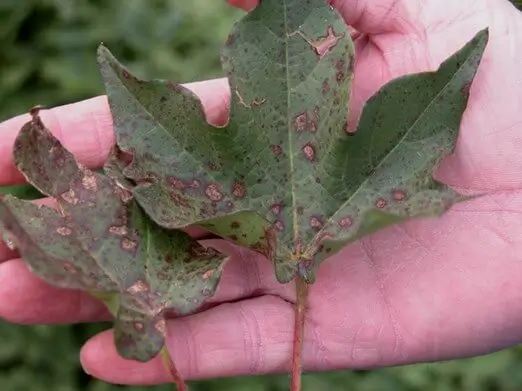
How Do Plants Affected by Alternaria Disease Look?
Alternaria Leaf Spot symptoms don’t just appear on leaves, if not treated in the early stages of the disease you can observe the symptoms on bracts and bolls.
Here are the key symptoms to look out for:
Leaf Spots: The symptoms on leaves appear as small, pale to brown, irregular or round spots. If you observe keenly these spots have central lesions surrounded by concentric rings. And these concentric rings are the sign it is Alternaria disease
Blighted Areas: Several spots can coalesce to form blighted areas. And the leaves affected with this disease become brittle and may fall off.
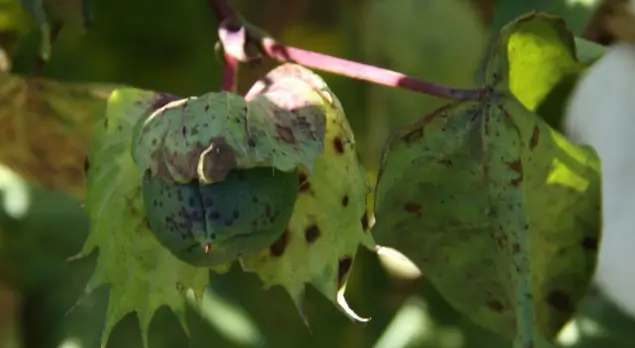
Bracts and Bolls: If not managed at early stages, these spots also appear on bracts and bolls, affecting the overall health and productivity of the plant.
Concentric Rings: Lesions often look like concentric rings, creating a target-like appearance. If the severity of the disease increases, the necrotic tissue may fall out, giving a “shot-hole” look.
Conditions for the Disease to Occur
Knowing how Alternaria Leaf Spot spreads is crucial for effective management of the disease:
The pathogen causing the disease can survive on infected crop debris as dormant mycelium and the initial spread of this disease occurs through these infected crop debris left in the field. This pathogen spreads to the healthy plant through air-borne conidia which facilitate the secondary spread of the disease, allowing it to infect healthy plants rapidly.
Favourable Conditions for the Disease Development
High humidity and intermittent rains coupled with moderate temperatures (25-28°C), create an ideal environment for the pathogen to thrive.
Management Practices to Keep the Plants Free From Alternaria
Effective management of Alternaria Leaf Spot involves a combination of cultural practices and chemical treatments:
Cultural Practices
As pathogens causing the disease can stay on plant debris, regularly remove and destroy infected plant residues which will help in preventing the pathogen from surviving and spreading.
The fungal pathogens die when exposed to heat therefore perform deep ploughing during summer.
While sowing, use seeds from healthy crops to prevent initial infections.
Chemical Treatments
Apply fungicides such as Copper oxychloride (500 g per acre), Chlorothalonil (200 g per acre), Difenoconazole (100 ml per acre), Kresoxim-methyl (200 ml per acre), Tebuconazole (200 ml per acre), Propiconazole (100 ml per acre) or Propineb 70% WP: (500 g per acre) at 60, 90 and 120 days after sowing.
Bacillus subtilis: Apply Bacillus subtilis at 400 g/acre on 60, 90 and 120 days after sowing.
Minimising Disease Impact
In addition to the above management strategies, minimising plant stress is essential:
Growing cotton in proper fertile soil is important, especially adequate potassium levels, to reduce disease severity as potassium deficiency is known to cause alternaria lef blight
But how is this possible?
Potassium deficiency in plants leads to thin cell walls, weakened stalks and stems, smaller and shorter roots, sugar accumulation in the leaves, and accumulation of unused nitrogen (N) which encourages disease infection. Each of these reduces the ability of the plant to resist entry and infection by fungal, bacterial and viral disease organisms.
Prevent drought stress through irrigation and avoid heavy fruit loads that can lead to premature senescence.
Cercospora Leaf Spot
The important symptom of Cercospora leaf spot in cotton is greyish spots on the leaves
Let’s Get to Know Symptoms Better
Cercospora Leaf Spot is caused by Cercospora gossypina which is responsible for the following symptoms:
If you are noticing round or irregular greyish spots appear on leaves it is Cercospora disease in cotton. Older leaves may develop spots with dark brown or blackish borders.
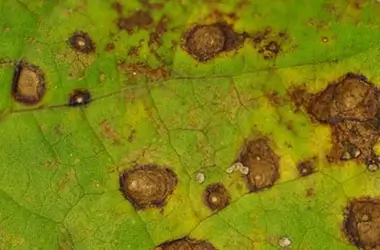
In the early stages of the disease, reddish-brown lesions are seen on leaves that enlarge with white to light brown centers and narrow red borders. These lesions are circular, up to 2 cm in diameter, often with concentric light and dark bands resembling target spots.
Conditions for Disease Spread
The pathogen causing the disease survives in infected plant debris as conidia. These Conidia are disseminated by wind or rain splash.
While planning to grow plants, ensure proper spacing between the plants as dense planting can exacerbate the spread.
The weather conditions are the major factor affecting the disease spread. Cloudy weather coupled with intermittent rain followed by dry weather and high relative humidity act as a favourable condition for the spread.
Management Strategies to Prevent Disease
Cultural Practices:
Regularly remove and destroy infected plant residues to prevent the pathogen from surviving and spreading.
Chemical Treatments:
Apply fungicides containing Mancozeb (400 g per acre), Copper oxychloride (500 g per acre), Carbendazim 50% WP (200 g per acre), Propiconazole (200 ml per acre), Metiram 55% + Pyraclostrobin 5% WG (200 g per acre) and Kresoxim-methyl 44.3% SC (200 ml per acre) at the intimation of the disease.
Minimising Disease Impact
In addition to the above management strategies, maintaining plant vigour is crucial:
Maintain proper soil fertility to prevent nutrient deficiencies that can exacerbate disease severity and ensure the field and the plants are adequately watered as drought stress conditions favours the disease development.
Diagnostic Notes
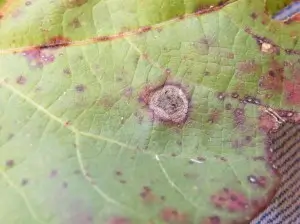
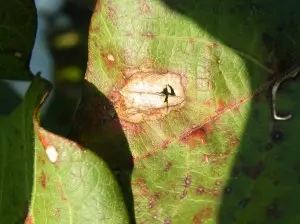
It is essential to differentiate Cercospora Leaf Spot from other foliar diseases such as Alternaria Leaf Spot and Stemphylium Leaf Spot, as they share similar symptoms. Correct diagnosis often requires viewing the long, thin whip-like, septate spores under a microscope.
Both Alternaria Leaf Spot and Cercospora Leaf Spot are the important foliar diseases that can significantly impact cotton production if not managed effectively. Farmers can protect their crops and ensure a healthy and productive cotton harvest if they understand the symptoms and implement practices accordingly as mentioned above.